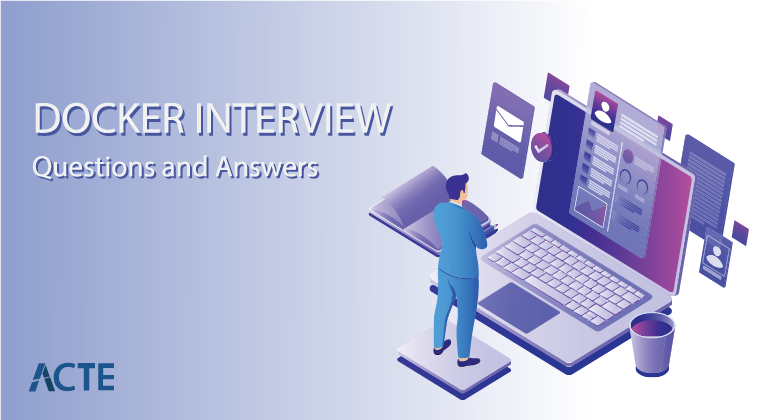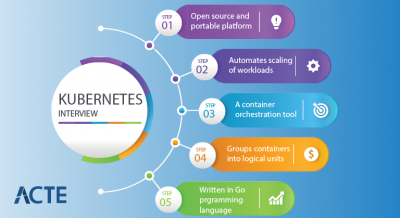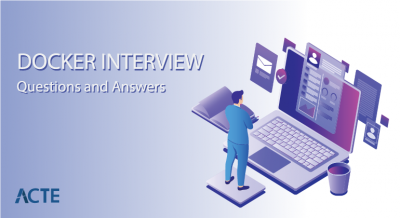
Released in 2013, Docker is a helpful tool for packing, shipping, and running applications within ‘containers’. Software engineers, Information Architects and DevOps engineers with Docker are in seriously high demand. As many big firms like Google, Amazon, and VMware have looked towards Docker as the go-to container technology, it is the right time to learn the tool and make a career out of it. If you wish to do so, below are the top Docker interview questions that you need to know.
1. List the most used commands of Docker.
Ans:
- Ps lists the running containers.
- Docker launches Docker Daemon.
- The build is used to build an image from a Docker file.
- Create creates a new image from the Container’s changes.
- The pull is used to download a specific idea or a repository.
- Run is used to run a container.
- Logs display the logs of a container.
- Rm removes one or more containers.
- Rmi releases one or more images.
- Stop is used to stop one or more containers.
2. Does the data get lost if the Docker container exits?
Ans:
No. Any data the application will write to disk can be well preserved in its Container until we explicitly delete the Container, and the file system will persist even after the Container halts.
3. How is Docker advantageous over Hypervisors?
Ans:
Docker is advantageous in the following way
1. It is lightweight.
2. More efficient in terms of resources.
3. It uses few resources and the underlying host kernel rather than developing its Hypervisor.
4. On what platforms does Docker run?
Ans:
Linux
- Ubuntu 12.04, 13.04 et al
- Fedora 19/20+
- RHEL 6.5+
- CentOS 6+
- Gentoo
- ArchLinux
- openSUSE 12.3+
- CRUX 3.0+
Microsoft Windows
- Windows Server 2016
- Windows 10
Cloud
- Amazon EC2
- Google Compute Engine
- Microsoft Azure
- Rackspace
5. What is Docker Engine?
Ans:
Docker Engine is a Client-Server application that is installed on the host machine. It will allow us to develop, assemble, ship, and run applications anywhere. It can be available for Linux or Windows servers. Its major components are as follows:
1. Server is a long-running program which is called a Daemon process (Docker)
2. REST API specifies interfaces that Docker will use to communicate with Daemon and instruct it what to do.
3. CLI (Command Line Interface) – It will use the Docker REST API to manage and interact with Daemon through its scripting commands.
6. What is the Lifecycle of Docker containers?
Ans:
- Create a Container.
- Run the created Container.
- Pause the processes running inside the Container.
- Unpause the processes running inside the Container.
- Start the Container if it exists in a stopped state.
- Stop both the Container and any ongoing processes.
- Restart both the Container and any active processes.
- Kill the running Container.
- Only destroy the Container if it is in a paused state.
7. Why is Docker needed?
Ans:
Docker is required to ease the creation, deployment, and delivery of an application called Containers. A Docker Container has just the minimum set of operating systems, not an entire operating system, software required for the application to run and rely on the host Linux Kernel.
8. What are the disadvantages of Docker?
Ans:
The following are the disadvantages of Docker:
1. Containers will not run at bare-metal speeds.
2. Containers consume resources more efficiently than virtual machines, but still, it is subject to performance overhead due to overlay networking, interfacing between containers and the host system, and so on.
9. What is the most popular use of Docker?
Ans:
The most common technologies running in Docker are:
1. NGINX: Docker is mainly used for deploying and running HTTP servers.
2. Redis: This popular key-value store is a regular feature at the top of the list of container images.
3. Postgres: The open-source relational database is steadily increasing in popularity.
10. Do we need a Docker?
Ans:
Docker will shine compared to virtual machines regarding performance because containers will share the host kernel and will not emulate a complete operating system. Docker does impose performance costs. If we are required to get the best possible performance out of the server, we may be required to avoid Docker.
11. Explain how you can clone a Git repository via Jenkins.
Ans:
To clone a Git repository via Jenkins, we must enter the email and username for the Jenkins system. To do that, we have to switch to the job directory and execute the “git config” command.
12. What are the essential features of Docker?
Ans:
The following are the essential features of Docker:
- Easy Modeling
- Version Control
- Placement/Affinity
- Application Agility
- Developer Productivity
- Operational Efficiencies
13. What command should you run to see all running containers in Docker?
Ans:
$docker ps
14. Write the command to stop the Docker Container.
Ans:
$ sudo Docker stop container name
15. Write a Docker file to create and copy a directory and build it using Python modules.
Ans:
FROM python:2.7-slim
WORKDIR /app
COPY. /app
docker build –tag
16. Where the docker volumes are stored?
Ans:
We are required to navigate
/var/lib/docker/volume
17. Can you use other composting files instead of the default YAML?
Ans:
Yes, The more popular version than YAML is the good-old JSON.
18. What is ‘NameSpaces’ used for?
Ans:
NameSpaces will isolate the Docker containers from other activities or tampering with them.
19. Is Container technology new?
Ans:
No, container technology is not new. Different variations of container technology have been out there in *the NIX world for a long time. Solaris containers (aka Solaris Zones)-FreeBSD Jails-AIX Workload Partitions (aka WPARs)-Linux OpenVZ are examples.
20. What is the use case for Docker?
Ans:
There are use cases where we can use Docker in production.
21. How exactly are containers (Docker in our case) different from hypervisor virtualization (vSphere)? What are the benefits?
Ans:
- To run an application in a virtualized environment (example for vSphere), we first must create a VM, install an OS inside, and only then deploy the application. To run the same application in Docker, we only need to deploy that application in Docker. There is no need for an additional OS layer. We deploy the application with its dependent libraries and docker engine (kernel, etc.), which will provide the rest.
- Another benefit of Docker is the speed of deployment.
- ACME Inc. will require virtualization of the GOOD APP for testing purposes.
22. How is Docker different from other container technologies?
Ans:
Docker is capable of getting more applications running on the same hardware compared to other technologies such as Kubernetes, Amazon Elastic Contain, etc, Learners who take Kubernetes Training Hyderabad and developers create ready-to-run containerized applications and make them manage, deploy, and share easily.
23. Can a container restart all by itself in Docker?
Ans:
No, it is not possible. The default –restart flag is set for never restarting its
24. What is a container?
Ans:
A container is a tiny, stand-alone, executable software package that includes everything required to run a piece of software, such as the code, runtime, libraries, and system utilities.
25.How is Docker different from virtualization?
Ans:
Virtualization involves creating virtual machines that run complete operating systems, while Docker uses containerization to isolate applications in lightweight containers that share the host OS kernel.
26. Explain the Docker architecture.
Ans:
Docker architecture consists of the Docker client, Docker daemon (server), Docker images, and Docker containers. The client communicates with the daemon, which builds, runs, and manages containers. Images are used to create containers.
27. Explain the image in Docker?
Ans:
A Docker image is a template that is read-only and comprises code. instructions for creating a container. Photos can be shared and versioned.
28. What is a Container in Docker?
Ans:
A Docker container is a containerized Docker image run. It encapsulates an application and its dependencies, ensuring consistent behavior across different environments.
29. How can you list all Docker containers?
Ans:
The command docker ps -a can be used.
30. How do you create a Docker container from an image?
Ans:
Use the command: Docker run <image-name>.
31. How can you remove a Docker container?
Ans:
Use the command: Docker rm <container-id>.
32. How does networking work in Docker?
Ans:
Docker containers can be connected to various network modes: bridge, host, overlay, etc., allowing them to communicate with each other and the host machine.
33. What is a Docker network bridge?
Ans:
A Docker bridge network allows containers on the same host to communicate with each other using IP addresses while providing isolation from external networks.
34. What is a Docker volume?
Ans:
A Docker volume is a a directory contained within one or more containers that avoids the Union File System, making it suitable for data storage that needs to persist beyond the lifecycle of a container.
35. Why would you use a Docker volume?
Ans:
Docker volumes are used to persist data, share data between containers, and provide a way to manage data outside the container’s lifecycle.
36. How do you create and manage Docker volumes?
Ans:
The docker volume creates command can be used to construct Docker volumes and manage them using the docker volume command set.
37. What exactly is Docker in Compose?
Ans:
Docker Compose is a tool for generating and managing containers. managing multi-container applications. Docker applications use a YAML file to configure the services, networks, and volumes.
38. How do you define services in a Docker Compose file?
Ans:
In a Docker Compose YAML file, you define services under the services section. Each service can include the image, ports, environment variables, volumes, etc.
39. How do you start containers using Docker Compose?
Ans:
You can start containers defined in a Docker Compose file using the docker-compose up command.
40. How can you scale services defined in a Docker Compose file?
Ans:
You can scale services using the docker-compose-up command with the –scale flag followed by the service name and desired number of instances.
41. How do you ensure security in Docker containers?
Ans:
You can enhance security in Docker by using official images, minimizing the attack surface, updating regularly, setting proper access controls, and isolating containers using networks and namespaces.
42. What is a Dockerfile best practice for security?
Ans:
Some best practises include using the COPY command instead of ADD to copy files, using a non-root user whenever possible, and avoiding running unnecessary processes in your image.
43. How can you restrict a container’s resource usage?
Ans:
You can restrict a container’s resource usage using Docker’s resource constraints, such as CPU and memory limits.
44. What is Docker Swarm?
Ans:
Docker Swarm is Docker’s native clustering and orchestration solution for deploying and maintaining containerized apps on a large scale.
45. What is Kubernetes?
Ans:
Kubernetes is an open-source container orchestration platform for automating containerized deployment, scaling, and management of applications.
46. What’s the distinction between Docker Swarm and Kubernetes?
Ans:
Docker Swarm is simpler to set up and use, while Kubernetes is more powerful and feature-rich, suitable for complex and large-scale deployments.
47. How do you monitor Docker containers?
Ans:
Docker provides monitoring tools like Docker Stats and the Docker API, and you can also use third-party monitoring solutions like Prometheus and Grafana.
48. How do you manage logs from Docker containers?
Ans:
Docker containers usually send logs to the standard output and error streams, which can be collected by Docker and forwarded to logging solutions like the ELK stack (Elasticsearch, Logstash, and Kibana).
49. What is Docker’s “COPY” command used for in a Dockerfile?
Ans:
To copy files, use the COPY command and folders from the host machine to the container image.
50. How does Docker achieve isolation between containers?
Ans:
Docker uses kernel namespaces and control groups (groups) to provide process and resource isolation between containers.
51. Explain the concept of a Docker overlay network.
Ans:
A Docker overlay network is a software-defined network that spans multiple Docker hosts, enabling communication between containers on different hosts.
52. What is the purpose of a Docker-compose override file?
Ans:
A Docker Compose override file is used to modify or extend the behavior of a Docker Compose file, enabling customization for different environments (e.g., development, production).
53. How can you pass environment variables to a Docker container?
Ans:
Environment variables can be passed to a Docker container using the -e flag with the docker run command or by specifying them in a Docker Compose YAML file.
54. What is the health check feature in Docker?
Ans:
Docker’s health check feature allows you to define a command that periodically checks the health of a container, helping to determine if the container is running properly.
55. How can you remove all stopped containers in Docker?
Ans:
You can remove all stopped containers using the command docker container prune.
56. Explain the difference between an ENTRYPOINT and CMD in a Dockerfile.
Ans:
The CMD instruction specifies the default command to be executed when a container is run, and it can be overridden. The ENTRYPOINT instruction, on the other hand, specifies the default executable and any arguments, and they cannot be overridden.
57. What is Docker Desktop, and how does it differ from Docker Community Edition (CE)?
Ans:
Docker Desktop is a tool for developing, building, and testing Docker applications on your local machine. It includes an easy-to-use graphical interface. Docker Community Edition (CE) is the open-source version of Docker for building and deploying containerized applications.
58. What is a multi-stage Docker build?
Ans:
A multi-stage Docker build is a technique that involves using multiple FROM instructions in a Dockerfile to create intermediate images, allowing you to build a final image with only the necessary artifacts.
59. How about a container-stop command?
Ans:
The following command should be used: container name: sudo docker stop.
60. How would you go about listing all of the currently running containers?
Ans:
Use the following command: $ docker ps.
61. What is the process of scaling a Docker container?
Ans:
Docker containers can be scaled to whatever size is required. Because of the platform’s versatility, you can have anything from a few hundred to tens of thousands to millions of containers as long as they all have continuous, unrestricted access to the appropriate memory and operating system.
62. How well do you understand the Docker system prune?
Ans:
This command clears all stopped containers, unused networks, caches, and hanging images. Prune is one of Docker’s most valuable commands. The syntax is as follows: prune docker system $
63. Describe some of the more complex Docker commands.
Ans:
Some advanced commands are as follows:
- Docker information. Displays system-wide Docker installation information.
- Docker yank. Downloads a picture
- Docker statistics. Docker images are provided as container metadata.
64. Downloaded pictures are listed. Is it possible to lose data stored in a container?
Ans:
Unless you destroy the container, the data stored in it stays.
65. On which platforms may Docker be run?
Ans:
The Linux platforms are as follows:
- CentOS 6+ is an ArchLinux distribution.
- CRUX 3.0+
- Fedora 19/20 and up
- RHEL 6.5+ Gentoo openSUSE 12.3+
- Ubuntu 12.04, 13.04, and so on
Docker can also run on the cloud platforms listed below:
- Amazon ECS
- ECS Amazon
- Google Compute Engine (GCE)
- Microsoft Azure Rackspace 22 is a cloud computing platform.
66. Which way is preferable for removing a container: the commands “stop container” followed by “remove the container” or the rm command alone?
Ans:
First, stop the container, then remove it. Here’s how it’s done:
$ docker halt container_id>
rm -f container_id $ Docker
- CONTAINER_ID:
- docker stop CONTAINER_ID
- The following command will be used to restart a certain Docker container with the container id as
- CONTAINER_ID:
- docker restart CONTAINER_ID
67. Is it possible for a container to restart on its own?
Ans:
A container cannot restart itself since the default option -reset is set to false.
68. How do the Docker daemon and client communicate with one another?
Ans:
You use a combination of Rest API, socket.IO, and TCP to enable communication.
69. Can you use Docker for continuous development (CD) and integration (CI)?
Ans:
You certainly can. Jenkins can be run on Docker, and integration tests may be conducted using Docker Compose
70. Is it possible for a container to restart on its own in Docker?
Ans:
To address the question directly, it is not possible. The -restart flag is set to never restart on its own by default. If you want to experiment with it, go ahead.
71. What is Docker’s benefit over hypervisors?
Ans:
Docker is lighter and more resource-efficient since it uses the host’s underlying kernel rather than developing its own hypervisor.
72. What exactly is hub in Docker?
Ans:
Docker hub is a registry service that is hosted in the cloud lets you connect to code repositories, develop and test images, store manually pushed images, and connect to the Docker cloud to deploy images to hosts. Throughout the development process, it serves as a centralised Container image discovery, distribution and change management, user and team collaboration, and process automation are all available as resources.
73. What exactly is Docker Swarm?
Ans:
Docker Swarm is best understood as Docker’s native method of Clustering implementation. Docker Swarm converts a collection of Docker hosts into a single virtual Docker host. It supports the normal Docker API as well as any other tool that can already communicate with a Docker daemon and can use Docker Swarm to scale to several hosts in a transparent manner.
74. What is the purpose of Dockerfile?
Ans:
A Dockerfile is nothing more than a set of instructions that must be given to Docker in order for it to automatically construct images by reading the instructions from the supplied file. A Dockerfile is a text file with directions. Using Docker, all of the commands that a user could run from the command line.
75. Can I use JSON instead of YAML in my Docker compose file?
Ans:
Yes, you can use JSON instead of the normal YAML in your Docker compose file. In order to use a JSON file with composing, you must give the filename as follows:
-f docker-compose up docker-compose.json
76. How big can Docker containers get?
Ans:
The best examples in web deployments such as Google and Twitter, as well as the best examples in platform providers such as Heroku and dotCloud, run on Docker, which can scale from hundreds of thousands to millions of containers running concurrently so that the OS and memory do not run out on the hosts that run all of these innumerable containers hosting your applications.
77. Will I lose my data if the Docker container terminates?
Ans:
There is no data loss when any of your Docker containers quits because any data that your application writes to the disc in order to preserve it is preserved. This will continue unless the container is specifically erased.
78. What is the most intriguing prospective usage of Docker in your opinion?
Ans:
The build pipeline is the most intriguing prospective use of Docker that I can think of. Most Docker experts are observed using hyper-scaling with containers to get a large number of containers on the host that it runs on. These are also notorious for being quite swift. The Docker framework is used to totally automate the development-test build workflow.
79. What is the latest buzz in virtualization and cloud computing?
Ans:
Docker is the newest and hottest trend in the world of virtualization and cloud computing since it is an ultra-lightweight containerization tool with plenty of potential to prove its worth.
80. How many containers may run on a single host?
Ans:
There can be as many containers as the environment allows depending on where Docker is hosting the containers. The number of containers that can execute in an environment is determined by the size of the application and the available resources (such as CPU and memory). Although containers do not generate newer CPUs on their own, they can certainly give effective ways of using the resources.
81. Is it possible to include a certain code or volume with COPY/ADD?
Ans:
This is simply accomplished by including the COPY or ADD directives in your docker file. If you wish to transfer your code along with any of your Docker images, this will be handy.
82. Will cloud automation supplant containerization any time soon?
Ans:
Docker containers are gaining popularity and will undoubtedly become an integral component of any professional Continuous Integration / Continuous Development pipelines. Having said that, it is the obligation of all key stakeholders in any organisation to take on the job of assessing the risks and benefits of adopting new technology on a regular basis.
83. Is it possible to determine the status of a Docker container?
Ans:
Running the command ‘docker ps -a’ will list all available Docker containers with their related statuses on the host.
84. What are the distinctions between ‘docker run’ and ‘docker create’?
Ans:
The most significant distinction is that we can build a Docker container in the Stopped state by using the ‘docker create’ command. We can also supply it with an ID that can be saved for future use.
This can be done by running the command ‘docker run’ with the -cidfile FILE_NAME argument, as shown below: ‘docker run -cidfile FILE_NAME’
85. What are the several states a Docker container can be in at any given time?
Ans:
A Docker container can exist in one of four states at any given time. These are the states in question:
• Running • Pausing • Restarting • Exiting
86. Is it possible to unpause a Docker container?
Ans:
To answer the issue directly, no, it is not feasible to remove a paused container from Docker. Before a container may be removed from a Docker container, it must be in the stopped state.
87. In Docker, is it possible for a container to restart on its own?
Ans:
To address the question directly, it is not possible. The -restart flag is set to never restart on its own by default. If you want to experiment with it, go ahead.
88. Which method is preferable for uninstalling containers: ‘docker rm -f’ or ‘docker stop’ followed by a ‘docker rm’?
Ans:
The best and preferred method the ‘docker stop’ command is used to remove containers from Docker. command, which will send a SIG_HUP signal to its recipients, allowing them the time needed to complete all finalisation and cleanup chores. Once this activity is performed, we can safely delete the container from Docker using the ‘docker rm’ command and so update the Docker registry
89. What is the difference between a Docker Image and a container?
Ans:
The Docker container is the docker image’s runtime instance.
Docker Image has no state, and its state never changes because it is merely a collection of files, whereas Docker Container has an execution state.
90. Is it possible for a container to restart itself?
Ans:
No, a container cannot restart on its own. By default, the -restart parameter is set to false.
91. Do you know why the docker system prune command is used? What exactly does it do?
Ans:
Prune docker system $
The command above is used to erase all halted containers, all inactive networks, all hanging images, and all build caches. It’s one of Docker’s most useful commands.
92. Will you lose your data if there is a Docker container?
Ans:
No, you will not lose any data if your Docker container terminates. Any data written to the container by your application is saved.
93. Where do you believe Docker is being used?
Ans:
Docker is used in the following applications:
- Configuration simplification
- Code Pipeline Administration
- Developer Efficiency
- Isolation of an Application
- Capabilities for Debugging
- Multi-tenancy
- Quick Deployment
94. What distinguishes Docker from other containerization methods?
Ans:
Docker containers are simple to set up on any cloud platform. When compared to other technologies, it can run more applications on the same hardware, it allows developers to quickly design ready-to-go containerized apps, It also simplifies application management and deployment. Containers can even be shared with your apps
95. Can I substitute JSON for YAML in my Docker compose file?
Ans:
You can create your compose file in JSON rather than YAML. To do so, give the JSON filename to use.
96. How did you use Docker in your previous role?
Ans:
Describe how you used Docker to aid with quick deployment. Explain how you scripted Docker and used it in conjunction with other tools such as Puppet, Chef, or Jenkins. If you have no previous practical experience with Docker but have prior expertise with other tools in a similar field, be honest and explain why
97. How big can Docker containers get? Are there any prerequisites for this?
Ans:
Large online deployments, such as Google and Twitter, use container technology. as well as platform providers like as Heroku and dotCloud. Containers can be grown to hundreds of thousands, if not millions, running in parallel. When it comes to needs, containers require RAM.
98. On which platforms does Docker run?
Ans:
This is a simple question, yet it can be tough. Before attending the interview, conduct some corporate research to see how the organisation uses Docker. In this response, make sure to mention the platform that the company is using.
Docker is compatible with the following Linux distributions:
Fedora 19/20+, Ubuntu 12.04, 13.04, and others
RHEL 6.5+
CentOS 6 and later
CRUX 3.0+ Gentoo ArchLinux openSUSE 12.3+
It is also suitable for use in production with Cloud systems and the services listed below:
Amazon ECS
ECS Amazon
Google Compute Engine (GCE)
Rackspace from Microsoft Azure
99. Is it possible to unpause a Docker container?
Ans:
No, it does not. A paused container cannot be removed. Before the container may be removed, it must be in a stopped state.
100. Can a container restart on its own?
Ans:
No, a container cannot restart on its own. By default, the -restart parameter is set to false.






